However, right now I want to talk about what happens when you do not shuffle the deck randomly. Think about what happens in ordinary card shuffling: you cut the deck in half and interleave the two halves back together by alternately taking small, random numbers of cards from each half. What you do not want to do is take exactly one card, or any fixed number of cards, from each half in alternate succession because that does not randomize the deck, it merely re-orders it. You can predict where each card is after every such shuffle. If you carry out this strict reordering, or "perfect shuffling", a number of times, the deck eventually returns to the same sequence it started with! In the 52-card deck, that number happens to be 8.
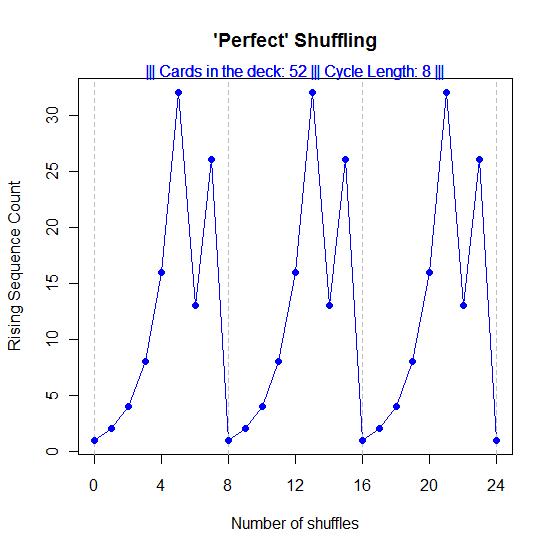
The figure above plots the number of "rising sequences" against the number of perfect shuffles. After 5 shuffles on the x-axis, RS=16 on the y-axis. The first blue dot represents the deck in starting position, with x=0 and y=1). I let the cycle run three times so you can see the pattern repeat.
In R, each unique card in the deck may be represented by a number in the sequence 1:52. Starting with a fresh deck is equivalent to starting with the R data vector seq(1:52). Cutting the deck exactly in half gives you two sequences, 1:26 and 27:52. After the first perfect shuffle you have this sequence:
1, 27, 2, 28, 3, 29, 4, 30,....,23, 49, 24, 50, 25, 51, 26, 52
1, 27, 2, 28, 3, 29, 4, 30,....,23, 49, 24, 50, 25, 51, 26, 52
Note: In random shuffling, RS reaches an average limit of 26.5. That is to say, once the deck has been shuffled enough times to fully randomize it, RS oscillates between 26 and 27, for eternity. I will talk about this more in a future blog post.
In the meantime, several things intrigued me about the plot above that I obtained from simulating perfect shuffling. For example, I did not anticipate the asymmetry in each cycle. It takes 5 shuffles for the deck to go from RS=1 to RS=16. But the deck goes from RS=26 to RS=1 in one step! That might seem reasonable upon some consideration since 26 is half the deck. You might even guess what the RS=26 sequence looks like, but it is easy enough to pull it out of the program if you cannot. Here is the R output following the 7th perfect shuffle, in standard reading frame, left-to-right, top-to-bottom. (The bracketed number in the first column is the position in the deck of the number just to the right of the bracket.)
[1] 1 3 5 7 9 11 13 15 17 19 21 23 25
[14] 27 29 31 33 35 37 39 41 43 45 47 49 51
[27] 2 4 6 8 10 12 14 16 18 20 22 24 26
[40] 28 30 32 34 36 38 40 42 44 46 48 50 52
One more perfect shuffle and the deck moves back into starting sequence.
The peak and valley between shuffles 5,6, and 7 intrigued me as well. Would you have expected the RS count to rise and fall like that? Look what happens when you add one more card to the deck. It takes 52 perfect shuffles to return a 53-card deck to its starting position.
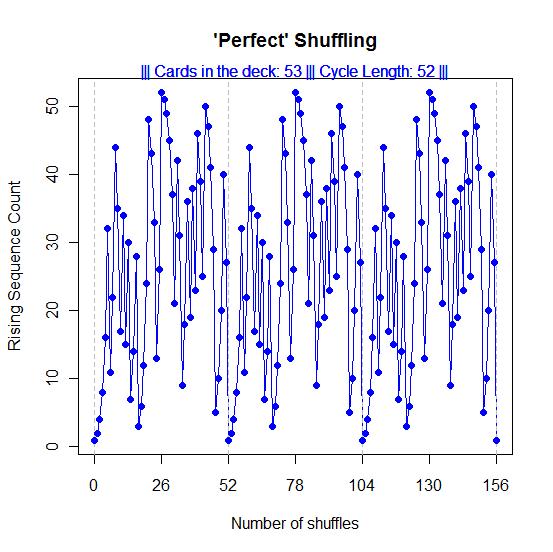
But if you add 40 cards to the deck you can get back to starting position in only 12 shuffles.
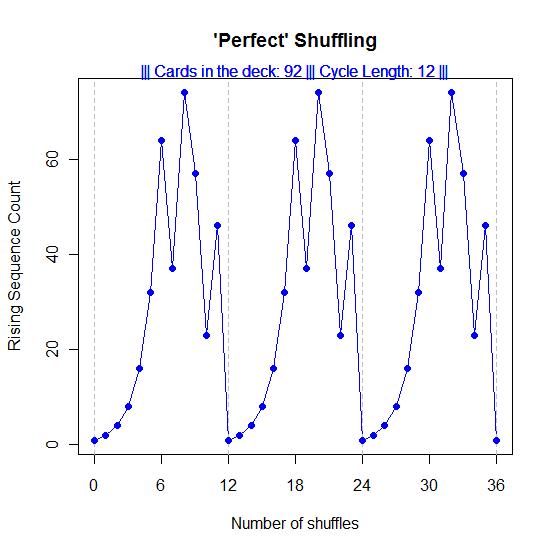
Let's consider the sequence 2n for n=1,2,3,..20.
> n=1:20
> 2**n
[1] 2 4 8 16 32
[6] 64 128 256 512 1024
[11] 2048 4096 8192 16384 32768
[16] 65536 131072 262144 524288 1048576
Decks of these sizes all return to starting position in n perfect shuffles. The program runs slow on my computer using a deck size 218 = 262144.
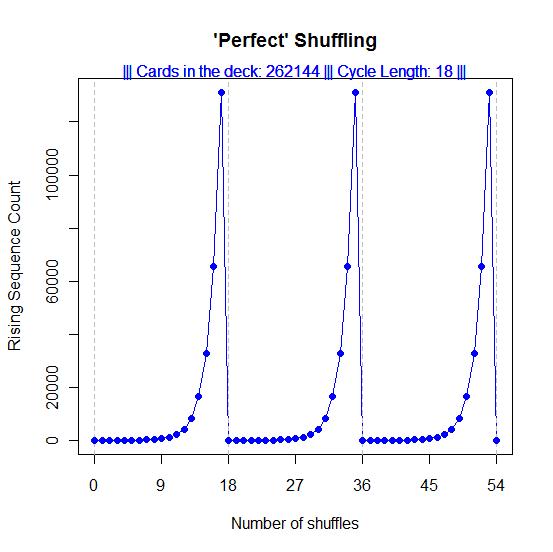
Several deck sizes had interesting symmetries in their RS counts. Here is the example of a 100-card deck:
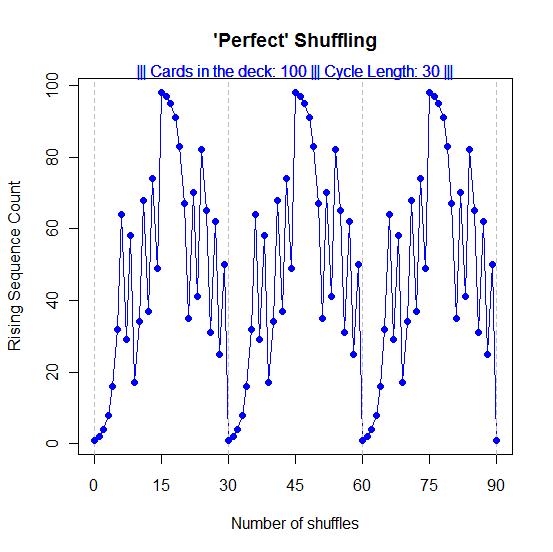
It takes 30 shuffles for the 100-card deck to return to its starting position. Note that the plot is symmetric with respect to a rotation about the y=50 axis, followed by a 15-point translation on the x-axis. (Similar, but not the same, symmetry exists in the 53-card deck above, although it is harder to see at first.)
Some large prime numbers possess the rotation-translation symmetry too. Here is deck size 331:

Deck size 19 is a small prime with the same symmetry, but it takes 18 shuffles to get back to start. And note how much more complicated the RS count is for 19 than the 2.7 times larger 52-card deck.
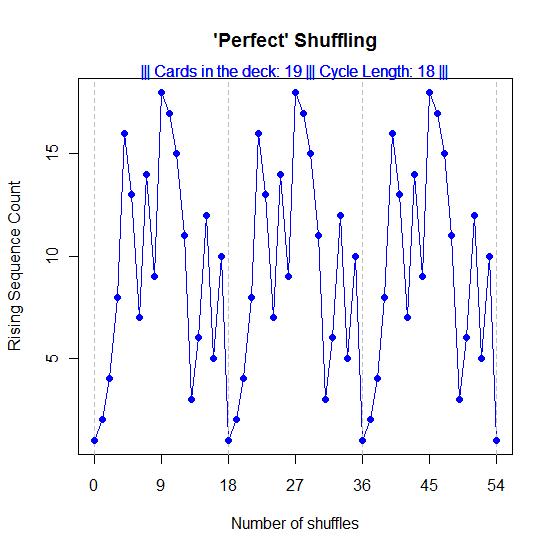
That's all I have time for right now. I'm not going to offer any explanations for the variation in RS counts as a function of deck size, let alone the various symmetries and asymmetries. I just wanted to illustrate how easy it can be find and explore some things you might not expect when using R.
I'll return to the shuffling topic later.
In the meantime, you're welcome to play around with my R code yourself. You'll find a draft of it here. Copy and paste it into an R New Script window. Then, scroll down toward the bottom and look for n=52 enclosed by pound signs. Change the number 52 to anything you want, and run the code. I recommend starting with numbers less than 100,000 at first. Let me know what you find!